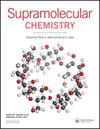Antibacterial potentials of pillar[5]arene, pillar[4]arene[1]quinone derivative and their isatin inclusion complexes
IF 2.6
4区 化学
Q3 CHEMISTRY, MULTIDISCIPLINARY
引用次数: 3
Abstract
ABSTRACT Host–guest complexation of decamethoxypillar[5]arene and difunctionalized pillar[4]arene[1]quinone with isatin were demonstrated by 1H NMR titration experiments. The antibacterial potentials of isatin, decamethoxypillar[5]arene, difunctionalized pillar[4]arene[1]quinone and their isatin inclusion complexes were evaluated against both Gram-positive and Gram-negative bacteria by the well-diffusion method. The results of the antibacterial assay revealed that decamethoxypillar[5]arene displayed very good antibacterial activity than the difunctionalized pillar[4]arene[1]quinone. Isatin inclusion complex of decamethoxypillar[5]arene showed very good antibacterial activity as that of chloramphenicol with S. aureus, P. aeruginosa, K. pneumoniae and E. coli. Checkerboard assay revealed synergic effects of P[5]A and isatin combinations against selected microorganisms. In silico toxicity predictions suggested the potential of isatin, decamethoxypillar[5]arene and the difunctionalized pillar[4]arene[1]quinone as prospective drug candidates. Graphical abstract Isatin inclusion complex of decamethoxy pillar[5]arene showed very good antibacterial activity as that of chloramphenicol with S. aureus, P. aeruginosa, K. pneumoniae and E. coli.柱[5]芳烃、柱[4]芳烃[1]醌衍生物及其isatin包合物的抑菌活性
摘要采用1H NMR滴定法研究了十甲基甲氧基柱[5]芳烃和双功能化柱[4]芳烃[1]醌与isatin的主客体络合作用。采用孔扩散法研究了isatin、十甲氧基柱[5]芳烃、双功能化柱[4]芳烃[1]醌及其isatin包合物对革兰氏阳性菌和革兰氏阴性菌的抑菌活性。抑菌实验结果表明,十甲基甲氧基柱[5]芳烃比双官能化柱[4]芳烃[1]醌具有很好的抑菌活性。十甲氧柱[5]芳烃Isatin包合物对金黄色葡萄球菌、铜绿假单胞菌、肺炎克雷伯菌和大肠杆菌的抑菌活性与氯霉素一样好。棋盘试验显示P[5]A和isatin组合对选定的微生物具有协同作用。在硅毒性预测中,isatin、十甲氧基柱[5]芳烃和双功能化柱[4]芳烃[1]醌具有潜在的候选药物潜力。十甲氧基柱[5]芳烃Isatin包合物对金黄色葡萄球菌、铜绿假单胞菌、肺炎克雷伯菌和大肠杆菌的抑菌活性与氯霉素一样好。
本文章由计算机程序翻译,如有差异,请以英文原文为准。
求助全文
约1分钟内获得全文
求助全文
来源期刊

Supramolecular Chemistry
化学-化学综合
CiteScore
3.60
自引率
3.00%
发文量
5
审稿时长
2.7 months
期刊介绍:
Supramolecular Chemistry welcomes manuscripts from the fields and sub-disciplines related to supramolecular chemistry and non-covalent interactions. From host-guest chemistry, self-assembly and systems chemistry, through materials chemistry and biochemical systems, we interpret supramolecular chemistry in the broadest possible sense. Interdisciplinary manuscripts are particularly encouraged. Manuscript types include: high priority communications; full papers; reviews, and; Methods papers, techniques tutorials highlighting procedures and technologies that are important to the field. We aim to publish papers in a timely fashion and as soon as a paper has been accepted and typeset it will be published in electronic form on the Latest articles section of the website. The two most important review criteria are that the paper presents high-quality work that fits generally into the broad spectrum of activities in the supramolecular chemistry field. Under normal circumstances, Supramolecular Chemistry does not consider manuscripts that would be more suitable in a highly specialized journal. This includes, but is not limited to, those based mostly or exclusively on topics such as solid state/X-ray structures, computational chemistry, or electrochemistry. .
The two most important review criteria are that the paper presents high-quality work that fits generally into the broad spectrum of activities in the supramolecular chemistry field.
 求助内容:
求助内容: 应助结果提醒方式:
应助结果提醒方式:


